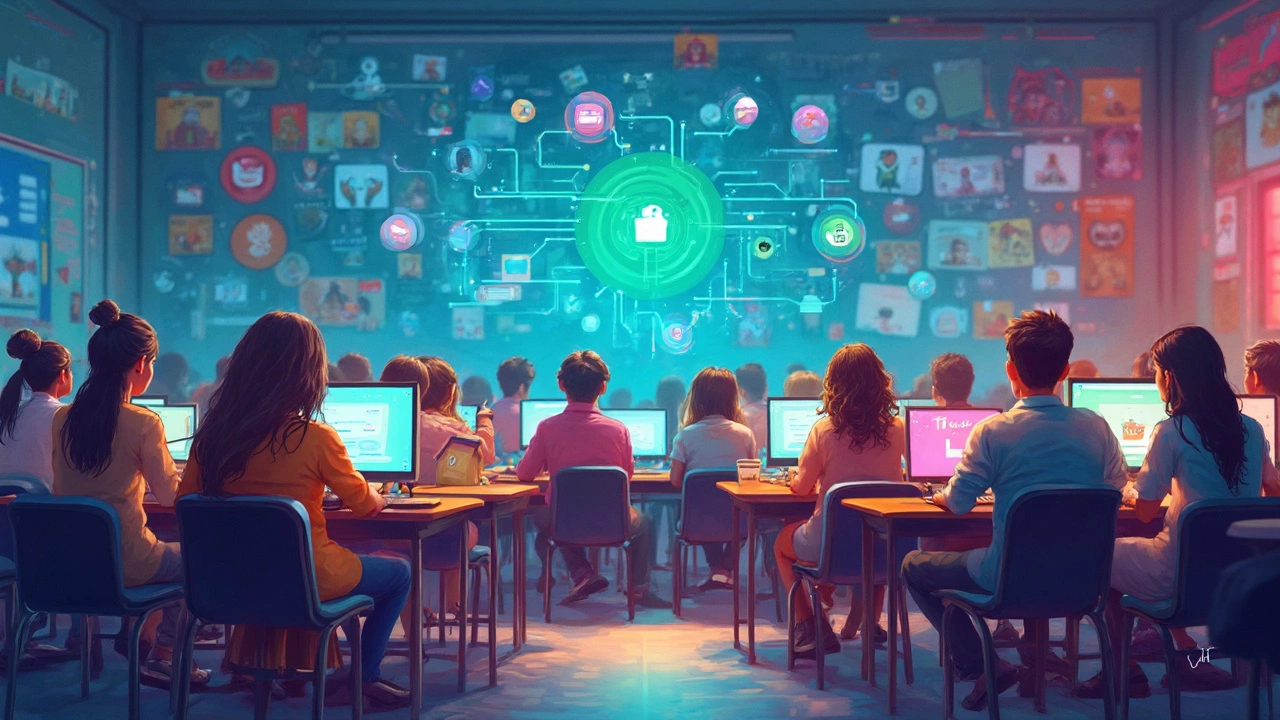
Alright, so when you think of Google, what's the first thing that pops into your head? Probably a search bar right there on your screen, ready to answer every weird question you've ever had. But let's shift gears a bit. Is Google just about searching cat videos or is there more under the hood, especially when it comes to e-learning?
A bunch of people might not realize that Google is far more than a search engine. Dive into the world of education, and you’ll see Google putting on a different hat—one that's all about enabling teachers and students worldwide. Think Google Classroom, Drive, and even Docs. These aren’t just tools—they're gateways, molding how knowledge travels across digital landscapes.
Now, the million-dollar question: is Google truly a digital platform in the realm of e-learning? Let's break it down. We've got Google Classroom turning bedrooms into classrooms since forever, making assignments float on the cloud instead of piling in dusty lockers. Then there's Google Drive, making file sharing as easy as pie.
For teachers and students, Google isn’t just a brand; it's a toolbox. Imagine teachers using forms for quizzes or students doing group work on Slides. Google’s resources are blending into the fabric of one’s everyday learning experiences. They’re not just bridging gaps but building entire bridges in digital education.
- Defining Digital Platforms
- Google’s E-Learning Tools
- How Educators Use Google
- Future of E-Learning with Google
Defining Digital Platforms
Alright, so let’s break it down. At its core, a digital platform is like a digital meeting place. It provides an environment where users can interact, share, and sometimes even create new content. Think of it like a virtual marketplace, but instead of just buying and selling, there’s a fair bit of collaboration and exchange.
Characteristics of Digital Platforms
- Connectivity: Probably the most vital trait, it connects users, allowing them to communicate with each other, access resources, and exchange information seamlessly.
- Interactivity: These platforms aren’t just a one-way street. Users can engage with each other and the system, leading to dynamic exchanges.
- Scale: With billions connected globally, scale matters. A robust digital platform can support numerous users without a hitch.
- Algorithmic: Often, they utilize intelligent algorithms to personalize content, recommendations, and even user interactions.
Now, does Google tick these boxes as an e-learning platform? Pretty much, yeah. Its suite of tools, from Google Classroom to Hangouts, provides the infrastructure for education exchange, resource sharing, and interaction on a global scale.
Types of Digital Platforms
Digital platforms aren't a one-size-fits-all kind of deal. Here's a bit more detail:
- Social Media Platforms: Facebook, Instagram – where social engagement is key.
- Content Sharing Platforms: YouTube, Medium – focus on sharing media and articles.
- E-Learning Platforms: Coursera, Udemy – dedicated spaces meant for educational content.
Interestingly, Google integrates elements of these categories, especially within its educational wing. This makes it a bit of a hybrid platform, blending search and educational resources in intriguing ways.
Whether it’s students working on joint projects or teachers sharing lesson plans, Google’s tools are intertwined into the very fabric of e-learning today. It’s less of a platform and more of an enabler, turning educators and students into active participants in this digital learning revolution.
Google’s E-Learning Tools
When we talk about Google in the realm of education, we're not just referring to a simple search engine that helps you find quick facts. It's like having a toolbox full of gadgets that make online learning a breeze. But what exactly are these e-learning tools?
Google Classroom
Think of Google Classroom as an online version of your school locker, but much cooler. Teachers can create classes, distribute assignments, and even provide grades. The best part? Students can pick up these assignments and submit them without having to remember where they kept that elusive paper.
Google Drive
Ah, Google Drive. It's like having a portable filing cabinet that travels with you everywhere. From documents and presentations to spreadsheets, Drive holds it all, making it easy for collaboration. Plus, with the ability to share and edit in real-time, it keeps everyone on the same page—literally!
Google Docs, Sheets, and Slides
These three are the dynamic trio in online education. Google Docs lets you write essays or papers that won’t get lost in the shuffle. Google Sheets is your go-to for handling data or tackling math problems. And Google Slides is there to help you present your ideas in a snazzy way. Each of these tools is designed so everyone can work together, whether they’re sitting side-by-side or oceans apart.
Google Meet
With Google Meet, online classes become a face-to-face affair, minus the constraints of geography. It’s like having a classroom in your living room, where teachers can lecture, students can collaborate, and everyone can share ideas—without worrying about missing the bus.
Stats and Facts
Did you know that Google Classroom was used by over 150 million users worldwide by 2023? There's a reason educators trust these tools. With continuous updates and a user-friendly interface, Google creates an environment where learning isn’t just effective; it’s also fun.

How Educators Use Google
When it comes to integrating technology into the classroom, educators are turning to Google as their go-to digital platform. It's not just because it's free—though that’s a sweet deal—but because of the sheer flexibility and range of tools at their disposal.
Google Classroom: The Digital Hub
Think of Google Classroom as the heart of a digital learning environment. Educators love it for its seamless workflow. They can set up classes, distribute assignments, and even grade papers without touching a single sheet of paper. It's like a teacher's assistant, minus the need for coffee breaks.
Collaboration with Google Docs
Gone are the days of passing notes in class. Now, group projects happen on Google Docs, where multiple students can type, comment, and edit all at once. Teachers have stepped up their game too. They use it to give real-time feedback, making learning an ongoing conversation rather than a one-way street.
Organizing with Google Drive
One shining star is Google Drive, which helps keep everyone's materials tidy. Teachers use it to store lesson plans, videos, and pretty much anything they need to share with students. Plus, with its cloud storage, nothing's ever really lost—except, maybe, your sense of time when browsing old files.
Feedback through Google Forms
Collecting feedback or quizzing students also got easier with Google Forms. Educators can create surveys, polls, and quizzes in no time. Auto-grade quizzes? Check. Anonymous feedback from students? Double check.
To sum it up, Google is transforming how educators interact with their students and deliver their lessons. It's not just about using tech for tech’s sake—it's about making teaching and learning smarter, easier, and way more connected. And hey, if that means less time organizing paper and more time teaching, educators are all in.
Future of E-Learning with Google
Thinking about the future of e-learning? It's hard not to consider the role of Google in reshaping how education unfolds. Google's ever-growing tech ecosystem is definitely setting the stage for a re-imagined educational experience.
Google Classroom is already a big player. It's paving the way for a more connected and personalized learning journey. As AI develops, imagine Google integrating smart systems that can suggest learning paths for students based on their performance trends. That'd be something, right?
Enhanced Collaboration Tools
The emphasis on teamwork isn’t going anywhere, and with Google's suite constantly expanding, students and teachers might soon have access to even more seamless collaboration tools. Think virtual reality classrooms where students are not just video-chatting, but actually engaging in immersive experiences right from their devices.
Focus on Accessibility
Google's commitment to accessibility means we’ll likely see more features aiding students with diverse needs. Voice-to-text capabilities and real-time translation tools might become standard components of classroom environments.
The Role of Data
Data analytics is bound to influence e-learning, too. Schools could use data-driven insights from students’ interactions with Google tools to tailor content, ensuring that learning is effective and engaging. Imagine using these insights to adjust teaching strategies in real time—sounds like a teacher’s dream!
Connectivity and Global Reach
With better connectivity, Google’s educational tools will reach remote areas, offering quality education where it's needed most. This global reach will enable information to travel faster and more efficiently, narrowing the education gap.
What’s clear is that the role of Google in the future of digital education is only growing, driven by continuous innovation and a commitment to making learning more inclusive and effective.
